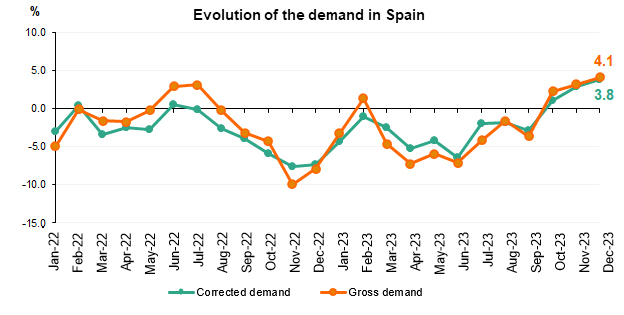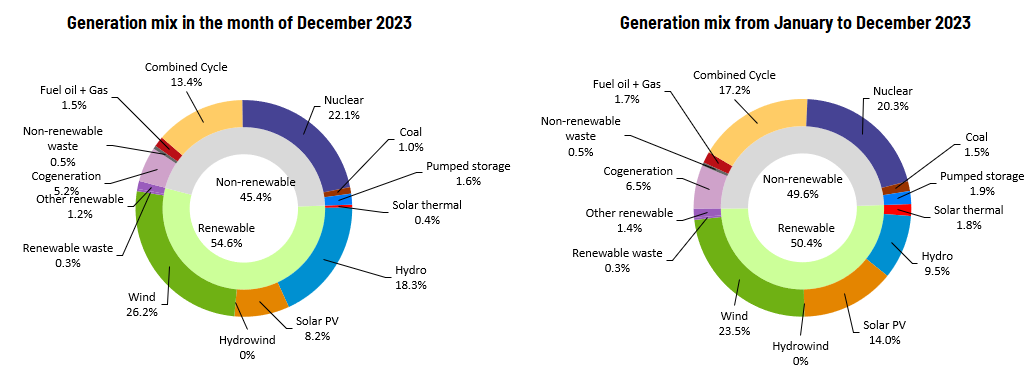For 40 years, we've been driving our country's economic and social progress. Four decades shaping Spain.
Demand for electricity in Spain grew 3.8% in December
- 54.6% of electricity production during the month came from renewable sources and 78% was obtained using zero-carbon energy technologies. This represents 24.6% more energy from renewable sources compared to December 2022.
- December closed a historic year for renewable energy, which has broken records in terms of both production and its share in the national generation mix (50.4%).
- In December 2023, electricity demand on the mainland was 3.7% higher than in the same month in 2022. Meanwhile, in the Balearic Islands and Canary Islands, electricity demand
National electricity demand in December experienced a 3.8% increase year-on-year after having factored in the influence of seasonal and working patterns. In gross terms, demand is estimated at 21,125 GWh, up 4.1% on December 2022.

Throughout 2023, Spain registered a cumulative demand of 244,686 GWh, down 2.3% on the value registered in 2022. Once again, after having factored in the influence of seasonal and working patterns, demand fell by 1.9% compared to last year.
In December, according to data available at the time of this press release, renewables accounted for 54.6% of the generation mix with 12,354 GWh. The contribution of renewables during the month was 24.6% higher than in the same period in 2022.
The good production values registered by renewables this month were mainly due to the contribution of wind power, the leading production technology for the third consecutive month, with a 26.2% share in the generation mix totalling 5,913 GWh. In addition, hydro power ranked third in the mix with 18.3% of the national total. For its part, solar photovoltaic energy contributed 8.2% to the overall mix in Spain in December and its generation grew by 64.1% compared to December 2022.
With provisional data as at 31 December, the annual production coming from renewable sources in Spain exceeded 50% for the first time ever (50.4%) and has broken records both in terms of share in the national mix and in GWh generated, reaching nearly 135,000 GWh, data that confirms Red Eléctrica's annual forecasts.
Furthermore, 78% of the month's electricity production was obtained using zero-carbon energy technologies.

Demand for electricity in the peninsular system
Regarding the mainland electricity system, and after having factored in the influence of seasonal and working patterns, demand for electrical energy in December was 3.7% higher than the same month in 2022. In gross terms, demand stood at 19,919 GWh, up 4.1% year-on-year.
Throughout 2023, electricity demand on the Spanish mainland stood at 229,526 GWh, a 2.5% decrease compared to 2022. Again, after having factored in the influence of seasonal and working patterns, demand fell by 2.1%.
Renewables as a whole generated 56.8% of the peninsular total and 81.4% of the electricity was obtained using zero-carbon energy technologies, while in 2023, the demand covered with renewables reached 52.3%.
Electricity demand in the Balearic Islands and the Canary Islands
Electricity demand in the Balearic Islands in December, after having factored in the influence of seasonal and working patterns, was 6.4% higher than in the same month in 2022. Thus, gross monthly demand is estimated at 423,222 MWh, up 6.1% on that registered in December 2022. In the year as a whole, gross demand in the Balearic Islands is estimated at 6,004,230 MWh, down 0.6% year-on-year.
In terms of generation, combined cycle, with 77.4% of the energy produced in the Balearic Islands, was the leading energy source in the islands in December. For its part, renewable energy obtained using zero-carbon energy technologies in the Balearic Islands, increased by 19.9% compared to the same month last year and represented 10.1% of the total.
In addition, during December, the subsea link between the mainland and Majorca contributed to covering 26.7% of the electricity demand in the Balearic Islands.
For its part, and after having factored in the influence of seasonal and working patterns, electricity demand in the Canary Islands increased 4.8% year-on-year. In gross terms, demand stood at 748,963 MWh, up 4.2%. In the year as a whole, demand in the Canary Islands is estimated at 8,764,819 MWh, up 2.7% compared to the same period in 2022.
In terms of electricity generation in the Canary Islands, combined cycle, with 48.6% of the total, was also the leading technology in December, while renewables and generation obtained using zero-carbon energy technologies accounted for 13.1% of production, up 67.8% on that registered in December 2022. Wind accounted for 9.7% of the total production in the Canary Islands.
Consult our Daily Balance Report for more information on the National, Peninsular, Balearic Islands and Canary Islands electricity systems as at the close of December.
Downloads












